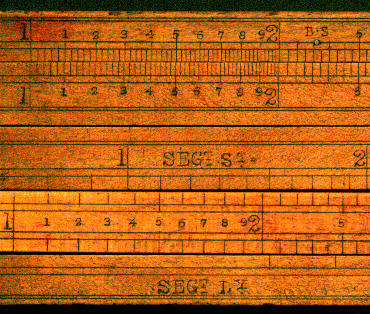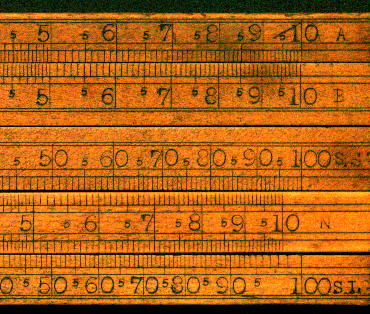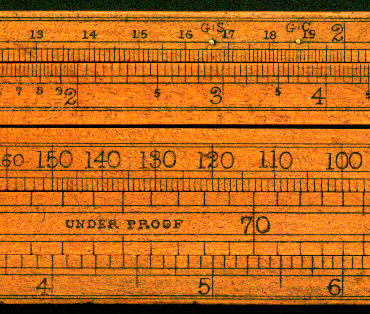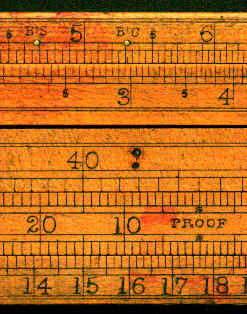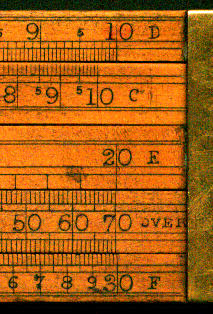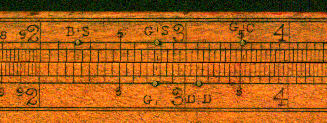1. This rule is an Everard type rule (though is not identical to the one Everard describes). The type was developed in 1683 to perform three functions related to alcohol and spirits:
- calculations related to "proof".
- calculation of volume from basic dimensions.
- calculations related to "ullage" (the gradual loss of content from a barrel).
This rule is capable of all three functions. It was constructed after the introduction of imperial gallons in 1824 so all volumes and contents refer to imperial units (gallons and bushels). The dimensions are in inches.
2. The rule has two slides and no cursor. Although proof rules generally did not have cursors, this rule was made at least 30 years after the invention of the cursor.
3. On the upper front of the rule are two scales (A stock and B slide). These are two
cycle logarithmic scales.They have gauge marks related to volume calculations and the
position is indicated by a brass pin set in the rule. Some are gauge marks used to
multiply other factors and some are divisors by which other factors are divided. They are:
A Scale
GS (Gallon - square vessel) = 16.65
GC (Gallon - cylindrical vessel) = 18.79
BS (Bushel - square vessel) = 2218 (divisor)
BS (Bushel - cylindrical vessel) = 2824 (divisor)
B scale
G (Gallon - cylindrical vessel) = 277.2 (divisor)
DD (p - 3.14)
4. On the upper back are two scales (D stock and C slide). The D scale is a single cycle logarithmic scale and C is a two cycle logarithmic scale. These also have gauge marks related to volume calculations. These have the GS, GC, BS, BC gauge points on the D scale. To find the volume of cylindrical cylinder set the length on the C scale, against the GC mark and against the diameter on the D scale read the contents in gallons on the C scale. For example for a cask 40 inches long and diameter of 27 inches, the volume would be 82.6 gallons. As a check the volume in cubic inches is 22902 and there are 277.274 cubic inches in a gallon.
5. The lower part of the front of the rule has two scales on the stock marked "SEGT. ST" (segment standing) and "SEGT LY" (segment lying) and between the slide marked N. These are for ullage calculations of how much is actually in the barrel when it is not quite full. The two scales are used for the cases of where the barrel is standing and where it is lying horizontally. If the barrel is standing set the depth of the barrel on the N scale against the 100 on the SEGT. ST scale. Against the depth of liquid on the N scale read the percentage of the contents on the SEGT. ST scale. Set the value of the percentage on the B scale against the central 1 on the A scale. Against the full volume on the B scale read the ullage on the A scale. For a barrel lying on its side use the SEGT LY scale rather than the SEGT. ST scale.
6. The lower part of the back of the rule has two scales on the stock for calculations. The lower slide has scale of "proof" (A measure alcohol content) from 80 under to 70 over proof. The scale above it on the stock is used to calculate how much alcohol or non-alcoholic liquid has to be added to achieve a known level of alcohol. The scale below it is used to calculate the excise duty on spirits which are above or below "proof". Note the this scale has 6 divisions between each marked number to facilitate calculations involving shilling and pence (the pence to one shilling).
8. The address of the maker is given on the edge of the rule. The maker was at this address from 1885 to 1936. The use of postal districts (e.g. E.C. for East Central) was introduced in 1858 and further extended in 1917. I have a rule dated 1861 to 1875 which uses the postal district. One could perhaps surmise that the absence of postal district on the address puts this rule toward the earlier part 1885 to 1936 range. On the other hand since postal districts had been introduced more than 20 years before the earliest of the addresses and they had not used then this might not be a valid hypothesis.
9. The rule also has a large J inscribed on the same edge as the maker's name. It looks slightly crude and might have been the initial of the owner or might have been J Long's trade mark.
10. The other edge of the rule has three scales on it. One is a scale of inches. The
others are marked "SPHD" and "2ND VARIETY". Casks were
usually divided into 4 varieties depending on the method of calculation of their volume.
The first variety is the middle frustum of a spheroid; the second, the middle frustum of a
parabolic spindle; the third, two equal frustums of a paraboloid united at their bases;
and the fourth, two equal conic frustums united at their bases. The actual method was a
function of the curvature of the staves used to make the cask. The function of these
scales was to estimate the equivalent diameter of a cylinder having the same length and
volume as the cask. For the first variety (i.e. spheroid) the equivalent diameter
was given by:
Equivalent diameter = Head diameter + 0.705 * (Bung diameter - Head
diameter)
For the second variety, the equation is:
Equivalent diameter = Head diameter + 0.645 * (Bung diameter - Head
diameter)
where:
Head diameter is the diameter at the "narrow" end
Bung diameter is the diameter at the middle.
The values on the SPHD and 2ND VARIETY scales represent the appropriate ratio
of the inch scale. The rule could then be used as above for the calculation of a
cylindrical calculator.
11. For more information on the use of such a rule see here.

